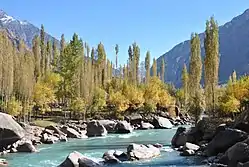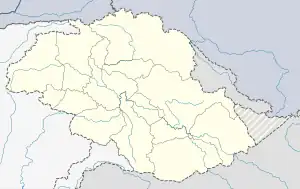Yasin Valley | |
|---|---|
 Yasin Valley, Gupis-Yasin District | |
 Yasin Valley Location in Pakistan  Yasin Valley Yasin Valley (Pakistan) | |
| Coordinates: 36°22′15″N 73°20′00″E / 36.37083°N 73.33333°E | |
| Country | Pakistan |
| Pakistan | Gilgit Baltistan |
| District | Gupis-Yasin District |
| Time zone | UTC+5 (PST) |
Yasin Valley is a high-altitude mountain valley nestled in the Hindu Kush mountain range, located in the northern region of the Gupis-Yasin District within the territory of Gilgit-Baltistan, Pakistan.[1][2] The valley is situated approximately 148 kilometers (92 miles) away from the city of Gilgit, which serves as the capital of Gilgit-Baltistan. Within the valley's territory lies the Yasin Tehsil, an administrative subdivision of the region.
| Princely state |
|---|
| Individual residencies |
| Agencies |
|
| Lists |

History
Despite its sparse population, Yasin Valley has held significant strategic importance historically. This is due to the fact that it leads to a high mountain pass leading to the Yarkhun Valley and subsequently to the Broghil Pass in Chitral. These passes facilitate connectivity with the Wakhan Corridor in Afghanistan and further extends to Tajikistan.
Early period
Yasin Valley served as the administrative center of Worshigum, which was under the suzerainty of the Mehtars rulers who emerged from Chitral. The Mehtars of Yasin were great warriors and fought against the Sikhs and the Dogras of Kashmir in Gilgit Agency. But more often, they fought with each other, intrigued and murdered each other.
In 1895, the British took control of the territory under the Gilgit Agency. By this point, Yasin had become firmly recognized as part of the princely state of Jammu and Kashmir.[3]
Yasin Mehtars
- c.1780 - 1804 Mulk Aman (died 1804)
- 1804 - 1805 Kuwat Khan
- 1805 - 1828/29 Sulayman Shah (d. 1828/29)
- 1829 - 1830/40 Mir Aman
- 1841 - 1860 Ghauhar Aman (Gur Rahma) (born 1809 - d. 1860)
- 1860 - 1880 Ghulam Mohiuddin (Pehlawan Mitar)
- c.1892 - 1911 Shah Abd ar-Rahman Khan (1st time) (b. 1877 - d. 1948?)
- 1923 - 19. Shah Abd ar-Rahman Khan (2nd time) (s.a.).
*Muhammad Waizer Khan *Ghulam Dastagir (Tham)
People
The primary languages of Yasin Valley are Burushaski language and Khowar Language. English Wakhi and Shina is also widely understood.
The majority of the people in Yasin are Ismailis, who lead their lives according to the Islamic principles more concerned with the imam of the time. Currently Aga Khan IV is the imam and spiritual leader of the Ismailis. However, other branches of both as Sunni and Shia Islam also live in Yasin. Ethnically, the people of Yasin are of Burusho origin; however, there are some migrants from different parts of the country.
The people of Yasin are known for their honesty, hard work and bravery. Havaldar Lalak Jan Shaheed who was given the Pakistan Military's highest award Nishan-e-Haider for his bravery in Kargil War in 1999, belonged to Hundur in Yasin valley.
Geography
Yasin is separated from the Ishkoman Valley by a high mountain pass. To reach Yasin one must take the Karakoram Highway north from Islamabad, and then turn left to reach Gupis in Ghizar. After Gupis, one continues northwest to reach the Yasin Valley.
The part of the valley where Khowar is spoken is known in the Shina language as Arinah.[4]
Villages
Administratively, Yasin constitutes Yasin Tehsil, which is part of Ghizer District. It is further divided into four local councils: Yasin, Sultanabad, Silgan and Thoi.
- Yasin consists of the villages of Chiliharang, Damalgan, Gindai, Noh, Morka, Atkash, Bujayot, Manichi, Thodass, Thaus, and Nazbar Valley. Thodass is the headquarters of this union council.
- Sultanabad union council consists of the villages of Chumarkhan, Taus, Barkhachi, Sultanabad (Met, Huyelti), Ghojalti, Sandi, Dalsandi and Qorqolti Valley. Taus is the headquarters of this union council.
- Selgaan union council consists of the villages of Barandass, Barkolti, Gulbashoroot, Chilpi, Sheghetan, Hundur, Tersat, Umalsat and Darkut, which leads to the Pass to Boroghol. Hundur is the headquarters of this union council.
- Thoi Valley union council consists of the villages of Ghaingchel, Ishkaibar, Karimabad, Dalkoi, Dapis, Shamsabad(Druch), Harp, Rahimabad, Kuno, Shot, Chiryat, Ishqamdass, Draskin, Nalti, Dass, Thelti, Ishqamghoro, Mahrakabun and Mushibarnala, which leads to Yarkhun Pass. Harp is the headquarters of this union council.
Passes
The Darkut Pass connects Yasin with Wakhan and Chitral, height 4,267 metres (13,999 ft), Buroghul pass connect Yasin with Brughol, height 3,798 metres (12,461 ft) while the Thoi Pass connects Yasin to Yarkhun Chitral, height 4,690 metres (15,390 ft). Assumber pass connects Yasin to Ishkoman. Darkot Pass is an historical pass which has been labelled as a restricted zone by the government of Pakistan. This pass used to be the shortest means of communication between the Oxus and Indus. Most tourism is along the Assumbur Pass to the Ishkoman Valley. one pass is from Darkot yasin to Thoi. Attar pass height 4,700 metres (15,400 ft) Connects Darkut with Ishkoman Valley and Attar Lake. Three passes from Nazbar yasin connect to Mastuj Chitral, height 5,009 metres (16,434 ft), one pass from Bujayote Nala to Bawoshter Ghizat Shamaran, one other pass from Khaimet bar to Chitral (sources Aina e Dardistan By Hidayat ullah Akhter, edited by Javed sajid Sultanabad Yasin).
Gallery

 Sandi Village
Sandi Village Darkot valley areal view form Attar pass side Yasin
Darkot valley areal view form Attar pass side Yasin

 River Yasin cross Barkolti
River Yasin cross Barkolti The lands of Yasin
The lands of Yasin
References
- ↑ "Yasin Valley in Ghizer District". Pamirtimes.net. 14 September 2017. Retrieved 8 September 2018.
- ↑ "Yasin Valley, Ghizer District, Gilgit-Baltistan". www.merawatan.pk. Retrieved 8 September 2018.
- ↑ Military Report and the Gazetteer of Gilgit Agency and the Independent Territories of Tangir and Darel (Second ed.), Government of India Press, 1928, pp. 55–59: "Owing to this succession of murders, the Government of India determined to separate the Khushwakt country from Chitral, and this resolution was given effect to in September 1895, when Shuja-ul-Mulk was confirmed as Mehtar of Chitral, and Governors were appointed on behalf of the Kashmir Durbar to rule over the Khushwakt districts of Yasin and Kuh, to which Ghizr was added in 1905."
- ↑ Grierson, George A. (1919). Linguistic Survey of India. Vol. VIII, Part 2, Indo-Aryan family. North-western group. Specimens of the Dardic or Piśācha languages (including Kāshmiri). Calcutta: Office of the Superintendent of Government Printing, India. p. 133.